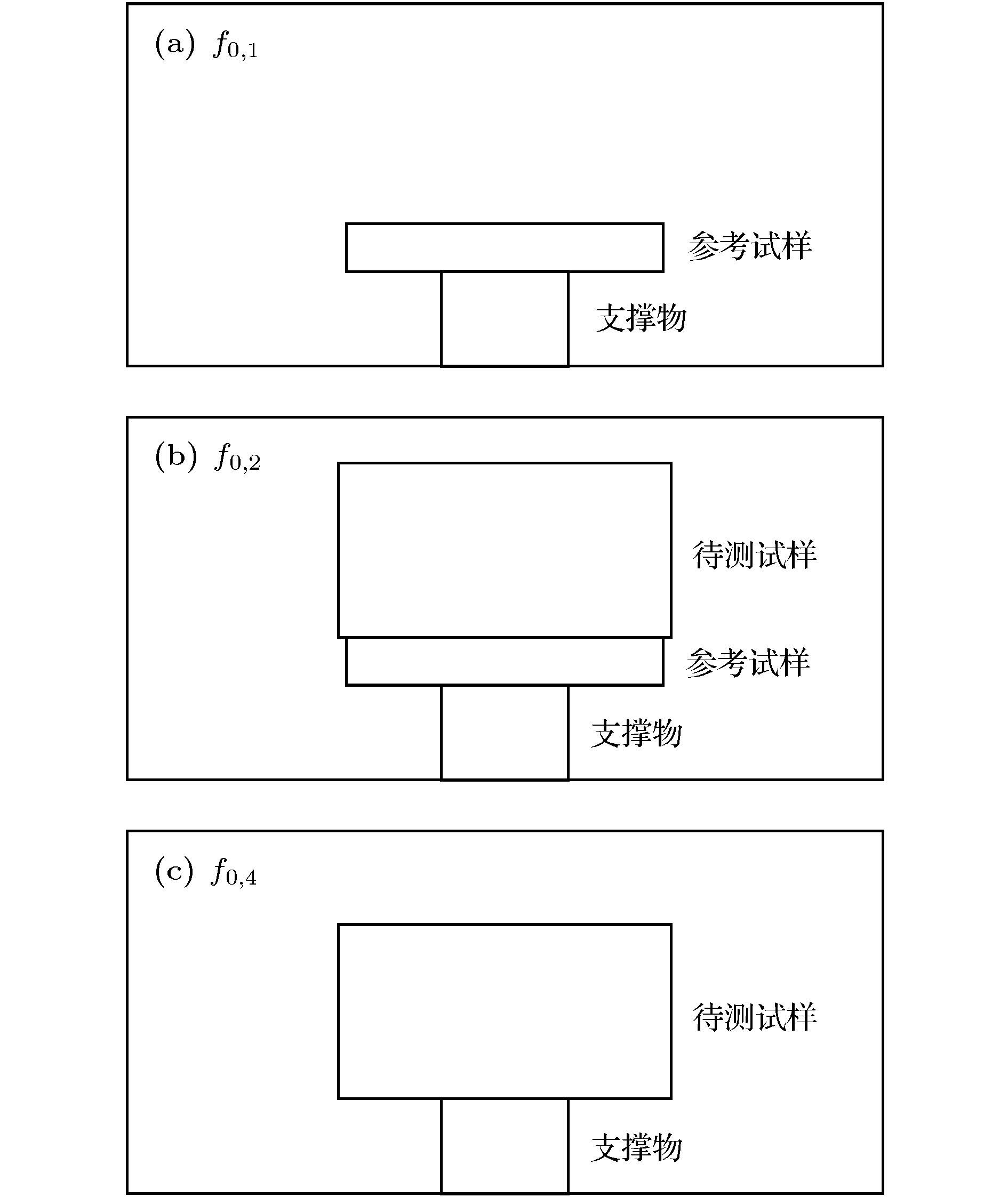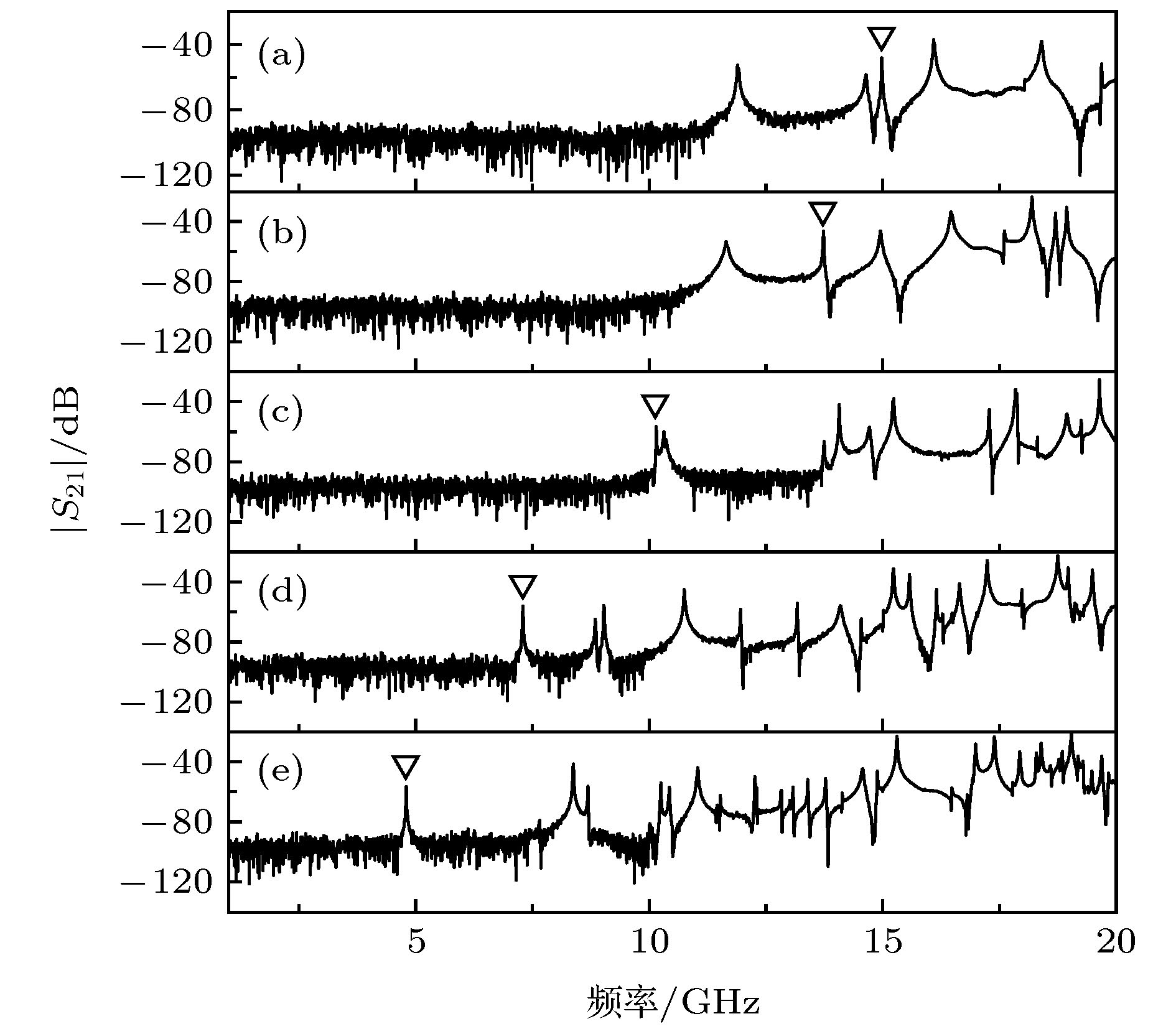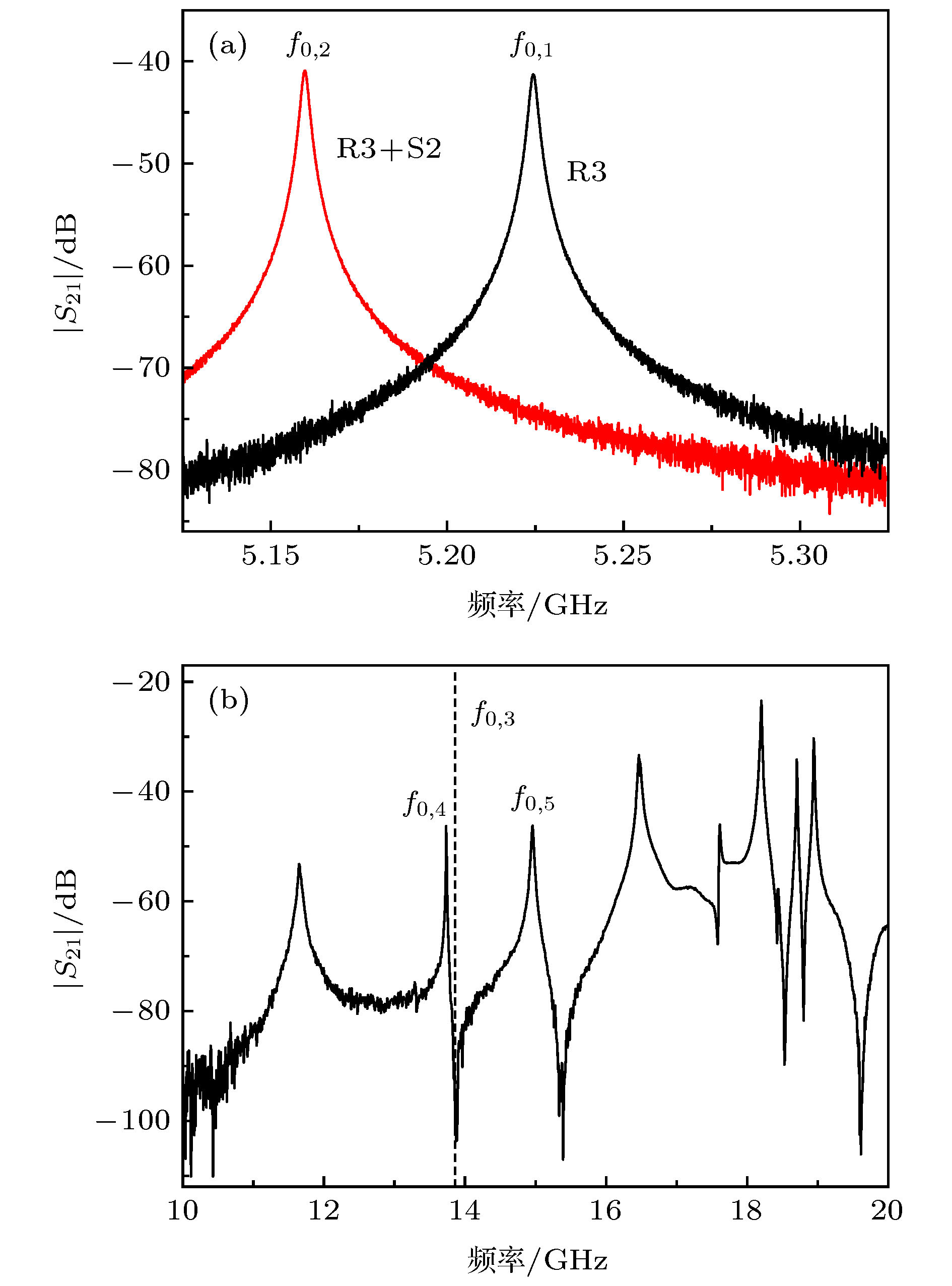-
工作于TE01δ模式的金属谐振腔法是评价低损耗材料微波介电性能的通用方法. 微波介质谐振器均为多模式谐振器, 故正确识别TE01δ模式是微波介电测试的基础. TE01δ模式的识别可通过预测谐振频率及其随谐振器尺寸的变化、根据激励条件排除寄生模式等手段实现, 但已有方法存在复杂、易识别错误等缺点. 为此, 本文发展了一种准确识别TE01δ模式的简单方法. 这种方法引入了介电性能已知的低损耗参考试样, 通过测试金属谐振腔中只放置参考试样及同时放置参考试样和待测试样时TE01δ模式的谐振频率, 利用有限单元分析计算出待测试样的粗略介电常数, 并进一步预测只放置待测试样时TE01δ模式的谐振频率. 此谐振频率的预测值与测试结果相差1%以内, 因此很容易将TE01δ模式与其他寄生模式区分开, 进而实现TE01δ模式的准确识别.The metal resonant cavity method working with TE01δ mode is a universal method for evaluating the microwave dielectric properties of low-loss materials. All the microwave dielectric resonators are multi-mode resonators, so the correct identification of TE01δ mode is the basis for the microwave dielectric measurements. The TE01δ mode can be identified by predicting the resonant frequency and its variation with resonator size, expelling the spurious modes according to the exciting conditions, etc., while these methods are relatively complex and sometimes unreliable. In the present work, a simple method for accurately identifying the TE01δ mode is developed. A low-loss reference sample with known dielectric properties is introduced and placed in the cavity for the first step, and the to-be-measured sample is placed on the reference sample for the second step. The rough permittivity of the to-be-measured sample can be calculated from the TE01δ-mode resonant frequencies in the two steps through the finite element analysis, and is used to predict the resonant frequency for TE01δ mode when only the to-be-measured sample is placed in the cavity. The difference between the predicted and measured TE01δ-mode resonant frequencies for the to-be-measured sample is less than 1%, so that the TE01δ mode can be easily distinguished from the spurious modes and accurately identified.
-
Keywords:
- microwave dielectric measurement /
- TE01δ mode /
- mode identification /
- finite element analysis
[1] Sebastian M T 2008 Dielectric Materials for Wireless Communication. (Oxford: Elsevier Science Publishers) pp1–48
[2] Narang S B, Bahel S 2010 J. Ceram. Process. Res. 11 316
[3] Sebastian M T, Ubic R, Jantunen H 2015 Int. Mater. Rev. 60 392
 Google Scholar
Google Scholar
[4] Chen L F, Ong C K, Neo C P, Varadan V V, Varadan V K 2004 Microwave Electronics: Measurement and Material Characterization (Chichester: John Wiley & Sons) pp37–141
[5] Kajfez D, Guillon P 1998 Dielectric Resonators (2nd Ed.) (Atlanta: Noble) pp327–430
[6] Hakki B W, Coleman P D 1960 IEEE Trans. Microwave Theory Tech. 8 402
 Google Scholar
Google Scholar
[7] Courtney W E 1970 IEEE Trans. Microwave Theory Tech. 18 476
 Google Scholar
Google Scholar
[8] Kajfez D 1984 IEEE Trans. Microwave Theory Tech. 32 941
 Google Scholar
Google Scholar
[9] Kobayashi Y 1985 IEEE Trans. Microwave Theory Tech. 33 1361
 Google Scholar
Google Scholar
[10] Dube D C, Zurmuhlen R, Bell A, Setter N, Wersing W 1997 J. Am. Ceram. Soc. 80 1095
 Google Scholar
Google Scholar
[11] Fan X C, Chen X M, Liu X Q 2005 IEEE Trans. Microwave Theory Tech. 53 3130
 Google Scholar
Google Scholar
[12] Krupka J, Huang W T, Tung M J 2005 Meas. Sci. Technol. 16 1014
 Google Scholar
Google Scholar
[13] Li L, Zhu J Y, Chen X M 2016 IEEE Trans. Microwave Theory Tech. 64 3781
 Google Scholar
Google Scholar
[14] Kajfez D, Gundavajhala A 1993 Electron. Lett. 29 1936
 Google Scholar
Google Scholar
[15] Alford N M, Breeze J, Penn S J, Poole M 2000 IEE Proc.: Sci. Meas. Technol. 147 269
 Google Scholar
Google Scholar
[16] Sebastian M T, Jawahar I N, Mohanan P 2003 Mater. Sci. Eng. B 97 258
 Google Scholar
Google Scholar
[17] Cho J Y, Yoon K H, Kim E S 2003 J. Am. Ceram. Soc. 86 1330
 Google Scholar
Google Scholar
[18] Li L, Chen X M 2006 J. Am. Ceram. Soc. 89 544
 Google Scholar
Google Scholar
[19] Li L, Chen X M 2006 J. Am. Ceram. Soc. 89 557
 Google Scholar
Google Scholar
[20] Li L, Chen X M, Fan X C 2006 J. Eur. Ceram. Soc. 26 3265
 Google Scholar
Google Scholar
[21] Li L, Chen X M 2009 Ferroelectrics 387 7
 Google Scholar
Google Scholar
[22] Wang D W, Zhou D, Zhang S Y, Vardaxoglou Y, Whittow W G, Cadman D, Reaney I M 2018 ACS Sustainable Chem. Eng. 6 2438
 Google Scholar
Google Scholar
[23] Zhang J, Luo Y, Yue Z X, Li L T 2019 J. Am. Ceram. Soc. 102 342
 Google Scholar
Google Scholar
[24] Li L, Chen X M, Ni L, Fu M S 2007 Appl. Phys. Lett. 91 092906
 Google Scholar
Google Scholar
[25] Li L, Fang Y, Chen X M 2012 J. Am. Ceram. Soc. 95 982
 Google Scholar
Google Scholar
[26] Li L, Zhang W, Chen X M, Zhu H Y 2012 J. Appl. Phys. 111 064108
 Google Scholar
Google Scholar
[27] Li L, Zhang B Q, Chen X M 2013 Appl. Phys. Lett. 103 192902
 Google Scholar
Google Scholar
[28] Li L, Wang Z W, Chen X M 2015 Mater. Res. Bull. 67 251
 Google Scholar
Google Scholar
[29] Krupka J, Derzakowski K, Tobar M, Hartnett J, Geyer R G 1999 Meas. Sci. Technol. 10 387
 Google Scholar
Google Scholar
[30] Kooi P S, Leong M S, Prakash A L S 1985 IEE Proc. H Microwave Opt. Antennas 32 7
 Google Scholar
Google Scholar
[31] Yuan H X, Chen X M, Mao M M 2009 J. Am. Ceram. Soc. 92 2286
 Google Scholar
Google Scholar
[32] O’Bryan H M, Thomson J, Plourde J K 1974 J. Am. Ceram. Soc. 57 450
 Google Scholar
Google Scholar
[33] Huang C L, Chen Y C 2003 Mater. Sci. Eng. A 345 106
 Google Scholar
Google Scholar
[34] Li L, Spreitzer M, Suvorov D 2014 Appl. Phys. Lett. 104 182902
 Google Scholar
Google Scholar
[35] Hong W B, Li L, Yan H, Wu S Y, Yang H S, Chen X M 2020 J. Materiomics 6 233
 Google Scholar
Google Scholar
[36] Li L, Hong W B, Chen G Y, Chen X M 2019 J. Alloys Compd. 774 706
 Google Scholar
Google Scholar
-
表 1 参考试样及待测试样的尺寸与介电常数
Table 1. Dimension and permittivity of references and to-be-measured samples.
类型 编号 直径/mm 厚度/mm εr 参考试样 R1 10.17 1.64 19.3 R2 10.86 1.48 39.4 R3 10.75 1.49 77.2 R4 9.36 1.04 434 待测试样 S1 12.03 6.51 2.79 S2 9.90 5.10 4.78 S3 10.00 5.00 9.50 S4 10.12 4.67 19.4 S5 10.83 5.44 39.2 表 2 不同参考试样/待测试样组合时各谐振频率的测试及计算结果
Table 2. Measured and calculated resonant frequencies for different reference/to-be-measured sample combinations.
参考
试样待测
试样f0,1/GHz f0,2/GHz f0,3/GHz f0,4/GHz f0,5/GHz R3 S1 5.224 5.184 15.107 14.988 14.642 R3 S2 5.224 5.160 13.862 13.736 14.958 R3 S3 5.224 5.067 10.216 10.158 10.360 R3 S4 5.224 4.849 7.358 7.298 9.035 R3 S5 5.224 4.217 4.830 4.800 8.376 R1 S2 10.046 9.498 13.807 13.736 14.958 R2 S2 7.215 7.028 13.789 13.736 14.958 R4 S2 2.760 2.752 13.830 13.736 14.958 表 3 TE01δ模式谐振频率、粗略介电常数的相对误差及介电性能测试结果
Table 3. Relative errors of TE01δ-mode resonant frequency and rough permittivity, and measured results of dielectric properties
Reference Sample (f0,3 – f0,4)/ f0, 4 εr,rou εr,sam (εr,rou – εr,sam)/εr, sam tanδ R3 S1 0.80% 2.73 2.79 –2.2% 1.08 × 10–4 R3 S2 0.92% 4.68 4.78 –2.1% 2.75 × 10–4 R3 S3 0.58% 9.38 9.50 –1.3% 2.56 × 10–5 R3 S4 0.83% 19.1 19.4 –1.5% 7.63 × 10–5 R3 S5 0.62% 38.7 39.2 –1.3% 1.21 × 10–4 R1 S2 0.51% 4.72 4.78 –1.2% 2.75 × 10–4 R2 S2 0.38% 4.74 4.78 –0.8% 2.75 × 10–4 R4 S2 0.68% 4.70 4.78 –1.8% 2.75 × 10–4 -
[1] Sebastian M T 2008 Dielectric Materials for Wireless Communication. (Oxford: Elsevier Science Publishers) pp1–48
[2] Narang S B, Bahel S 2010 J. Ceram. Process. Res. 11 316
[3] Sebastian M T, Ubic R, Jantunen H 2015 Int. Mater. Rev. 60 392
 Google Scholar
Google Scholar
[4] Chen L F, Ong C K, Neo C P, Varadan V V, Varadan V K 2004 Microwave Electronics: Measurement and Material Characterization (Chichester: John Wiley & Sons) pp37–141
[5] Kajfez D, Guillon P 1998 Dielectric Resonators (2nd Ed.) (Atlanta: Noble) pp327–430
[6] Hakki B W, Coleman P D 1960 IEEE Trans. Microwave Theory Tech. 8 402
 Google Scholar
Google Scholar
[7] Courtney W E 1970 IEEE Trans. Microwave Theory Tech. 18 476
 Google Scholar
Google Scholar
[8] Kajfez D 1984 IEEE Trans. Microwave Theory Tech. 32 941
 Google Scholar
Google Scholar
[9] Kobayashi Y 1985 IEEE Trans. Microwave Theory Tech. 33 1361
 Google Scholar
Google Scholar
[10] Dube D C, Zurmuhlen R, Bell A, Setter N, Wersing W 1997 J. Am. Ceram. Soc. 80 1095
 Google Scholar
Google Scholar
[11] Fan X C, Chen X M, Liu X Q 2005 IEEE Trans. Microwave Theory Tech. 53 3130
 Google Scholar
Google Scholar
[12] Krupka J, Huang W T, Tung M J 2005 Meas. Sci. Technol. 16 1014
 Google Scholar
Google Scholar
[13] Li L, Zhu J Y, Chen X M 2016 IEEE Trans. Microwave Theory Tech. 64 3781
 Google Scholar
Google Scholar
[14] Kajfez D, Gundavajhala A 1993 Electron. Lett. 29 1936
 Google Scholar
Google Scholar
[15] Alford N M, Breeze J, Penn S J, Poole M 2000 IEE Proc.: Sci. Meas. Technol. 147 269
 Google Scholar
Google Scholar
[16] Sebastian M T, Jawahar I N, Mohanan P 2003 Mater. Sci. Eng. B 97 258
 Google Scholar
Google Scholar
[17] Cho J Y, Yoon K H, Kim E S 2003 J. Am. Ceram. Soc. 86 1330
 Google Scholar
Google Scholar
[18] Li L, Chen X M 2006 J. Am. Ceram. Soc. 89 544
 Google Scholar
Google Scholar
[19] Li L, Chen X M 2006 J. Am. Ceram. Soc. 89 557
 Google Scholar
Google Scholar
[20] Li L, Chen X M, Fan X C 2006 J. Eur. Ceram. Soc. 26 3265
 Google Scholar
Google Scholar
[21] Li L, Chen X M 2009 Ferroelectrics 387 7
 Google Scholar
Google Scholar
[22] Wang D W, Zhou D, Zhang S Y, Vardaxoglou Y, Whittow W G, Cadman D, Reaney I M 2018 ACS Sustainable Chem. Eng. 6 2438
 Google Scholar
Google Scholar
[23] Zhang J, Luo Y, Yue Z X, Li L T 2019 J. Am. Ceram. Soc. 102 342
 Google Scholar
Google Scholar
[24] Li L, Chen X M, Ni L, Fu M S 2007 Appl. Phys. Lett. 91 092906
 Google Scholar
Google Scholar
[25] Li L, Fang Y, Chen X M 2012 J. Am. Ceram. Soc. 95 982
 Google Scholar
Google Scholar
[26] Li L, Zhang W, Chen X M, Zhu H Y 2012 J. Appl. Phys. 111 064108
 Google Scholar
Google Scholar
[27] Li L, Zhang B Q, Chen X M 2013 Appl. Phys. Lett. 103 192902
 Google Scholar
Google Scholar
[28] Li L, Wang Z W, Chen X M 2015 Mater. Res. Bull. 67 251
 Google Scholar
Google Scholar
[29] Krupka J, Derzakowski K, Tobar M, Hartnett J, Geyer R G 1999 Meas. Sci. Technol. 10 387
 Google Scholar
Google Scholar
[30] Kooi P S, Leong M S, Prakash A L S 1985 IEE Proc. H Microwave Opt. Antennas 32 7
 Google Scholar
Google Scholar
[31] Yuan H X, Chen X M, Mao M M 2009 J. Am. Ceram. Soc. 92 2286
 Google Scholar
Google Scholar
[32] O’Bryan H M, Thomson J, Plourde J K 1974 J. Am. Ceram. Soc. 57 450
 Google Scholar
Google Scholar
[33] Huang C L, Chen Y C 2003 Mater. Sci. Eng. A 345 106
 Google Scholar
Google Scholar
[34] Li L, Spreitzer M, Suvorov D 2014 Appl. Phys. Lett. 104 182902
 Google Scholar
Google Scholar
[35] Hong W B, Li L, Yan H, Wu S Y, Yang H S, Chen X M 2020 J. Materiomics 6 233
 Google Scholar
Google Scholar
[36] Li L, Hong W B, Chen G Y, Chen X M 2019 J. Alloys Compd. 774 706
 Google Scholar
Google Scholar
计量
- 文章访问数: 11895
- PDF下载量: 262
- 被引次数: 0














 下载:
下载:


